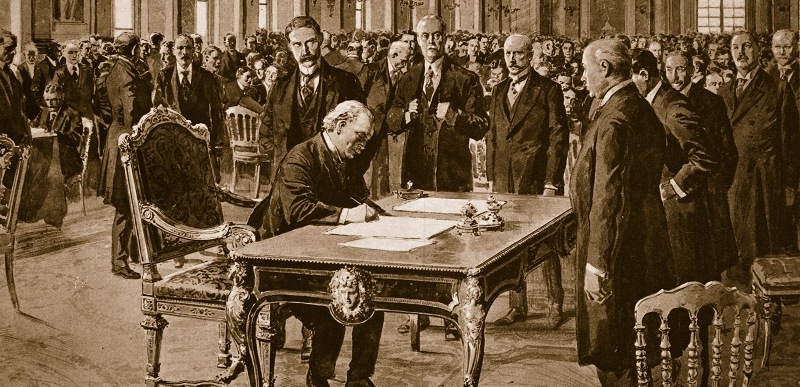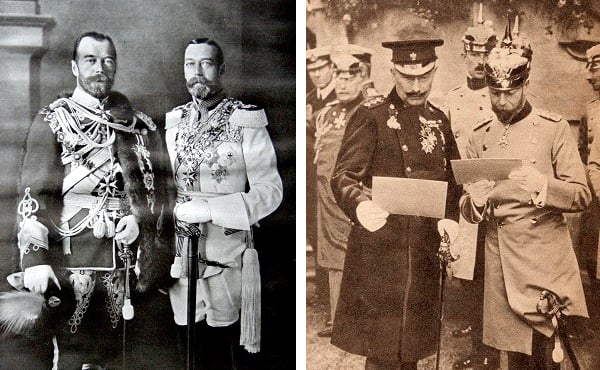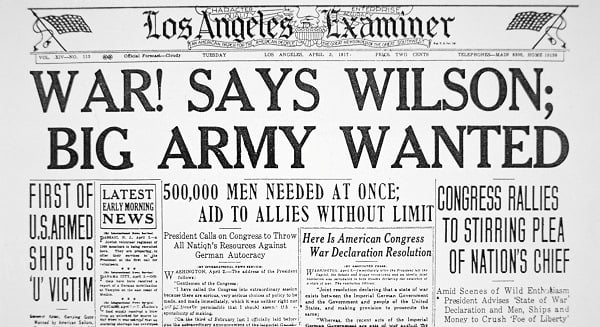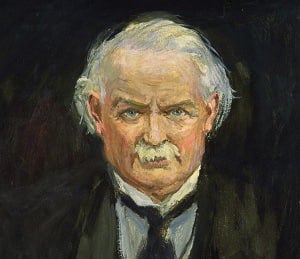
Key Figures of World War I
Many different nations were involved in the Great War. It is therefore not surprising that royals and political personalities played significant roles during the conflict.
How it all began: Archduke Franz Ferdinand of Austria
Franz Ferdinand was the nephew of Emperor Franz Joseph and heir to the throne of the Austria-Hungarian Empire. The assassination of the Archduke and his wife, Sophie Gräfin Chotek, in Sarajevo is widely considered as the event that triggered World War I. After political discussions failed, Austria-Hungary declared war on Serbia. Pre-existing alliances also brought Germany and Russia into the conflict.

Left: Archduke Franz Ferdinand of Austria (colour litho), Unknown Artist / Private Collection / Peter Newark Historical Pictures Right: Photograph of the Archduke and Duchess leaving the Town Hall, a few minutes before their deaths on 28th June 1914, 1914, Austrian Photographer (20th century) / Private Collection
Kaiser Wilhelm II was the last German emperor. After the assassination of Franz Ferdinand he encouraged Austria-Hungary to take action against Serbia. Although he was military leader of the German army, the real power lay with the generals. He was forced to abdicate the throne in 1918.
Famliy Ties: Kaiser Wilhelm II, Tsar Nicholas II and King George V
Tsar Nicholas II was a cousin through marriage of the German emperor Wilhelm II which put him into a delicate position. The Tsar hesitated at first but felt obliged to enter the war to defend Serbia.
A first cousin to both, King George V paid numerous visits to troops on the frontline, which made him more and more popular with his people.

Left: Tsar Nicholas II and his cousin King George V, 1913 (b/w photo) / Private Collection
Right: King George V and Kaiser Wilhelm II discussing operation orders in Germany in 1913, illustration from ‘The Life of King George V’, published c.1935 (b/w photo), English Photographer, (20th century) / Private Collection / Photo © Ken Welsh
The USA declared neutrality under President Wilson at the beginning of the war in 1914. As he grew up during the American Civil War, Wilson wanted to spare his nation the horrors of war. However, due to German submarine warfare affecting Americans, the USA declared war on the Central Powers in 1917. Woodrow Wilson

‘War! says Wilson; Big Army Wanted’, front page of the ‘Los Angeles Examiner’, 3rd April 1917 (print), American School, (20th century) / Private Collection / Peter Newark American Pictures
Georges Clemenceau
In the early years of WW1, Georges Clemenceau, the former French Prime Minister, was an outspoken critic of the French army’s efforts. Late in 1917, he was re-appointed as Prime Minister and saw France through to victory the following year. At the Treaty of Versailles, Clemenceau wanted to severely punish Germany, but was tempered by Lloyd George and Wilson.

Council of Four at the Versailles Peace Conference 1918. Left to right: Vittorio Emmanuele Orlando, Prime Minister of Italy: David Lloyd George, Prime Minister of Britain: Georges Clemenceau, Prime Minister of France, and (Thomas) Woodrow Wilson, President of the USA. Standing are confidential secretaries. / Universal History Archive/UIG
British Prime Ministers Herbert Asquith and David Lloyd George
Herbert Asquith was Prime Minister when World War I started. After a series of political and military misjudgements he became increasingly unpopular with the nation and was finally replaced by the Chancellor of Exchequer David Lloyd George at the end of 1916. David Lloyd George was a key figure in fighting off the growing German submarine menace.

David Lloyd George, 1922 (oil on canvas), Lavery, John (1856-1941) / Dublin City Gallery, The Hugh Lane, Irelandpossible copyright restrictions apply, consult national copyright laws
Find out more
All images in this article are sourced from www.bridgemanimages.com. Contact the Bridgeman sales team (uksales@bridgemanimages.com) for more information regarding licensing, reproduction and copyright issues.
See more images and footage of leaders and key figures in WWI.
